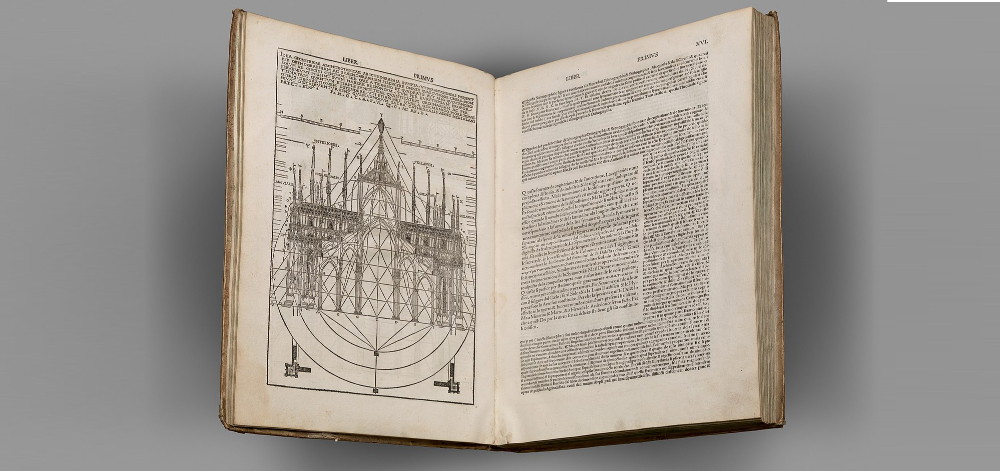Pattern book
The term 'pattern book' is normally used to refer to a book of samples or examples. It might be used in relation to fabric or wall paper selections, but also in design as a guide or set of instructions for certain objects with drawn examples.
An architectural pattern book, in particular might contain different example drawings of elements and distinctive features of types of building, or in urban planning, different street blocks and neighbourhood layouts..
One of the first set of what might be called architectural pattern books, was a series of Ten Books on Architecture, written and illustrated by the architect Vitruvius. Although some may refer to this as Illustrated architectural book or design code, it is in many ways a pattern book as it not only standardised the planning and construction of military camps and towns throughout the Roman Empire, but also codified the correct use of architectural orders for columns, entablatures and entranceways.
In doing this,Vitruvius provided a complete description of planning and building associated processes, in effect creating a framework for replication, practical instruction and dialogue that spanned centuries. Palladio too, as a follower of Vitruvius produced his Four Books of Architecture which might be considered a treatise and in a way a pattern book.
By the late 1700's many pattern books targetted potential client or noble landowners, containing illustrations of different types of housing designs. These books slowly developed and were not all tomes as Vitruvius had written but ranged from larger books to small booklets, designed as much for builders and carpenters as for clients. The books allowed users to share and popularise designs and to follow or recreate a given pattern outlined in them.
By the time the UK entered the Georgian era, and a period of mass development, pattern books had became important tools to both build with, but also as a form of marketing for the Georgian style,not only in the UK but also America, India, and Australia. By the 1800's in America many practical publications, builder’s companions and carpenter’s manuals were published such as Asher Benjamin’s American Builder’s Companion (1806); Owen Biddle’s The Young Carpenter’s Assistant (1805); and Minard Lafever’s The Modern Builder’s Guide (1833).
In 1881 two brothers by the name of Mitchell, embarked on an almost 30-year journey of writing, updating and modifying what became two separate construction books, the First Stage or Elementary and the expanded Advanced and Honours series, of the Mitchell’s construction books. Published initially by Batsford, and later Routledge they have become seminal books from this period giving both an understanding of design and construction for this period, but also showing the way to upgrade and or repair historic structures.
Pattern books and studies of buildings styles and methods continued to be recorded and shared throughout the 1900's. As digitisation grew and the availability of the first commercial Computer Aided Design (CAD) packages were a reality, digitalised pattern books of whole house designs for a variety of house types and styles were on offer. Today, off the shelf designs in 3 dimensional format can purchased by self builders along with more accessible tools to design bespoke schemes.
These to some extent owe a debt right back to the original pattern books that shared specialist knowledge and made it more readily available.
[edit] Related articles on Designing Buildings
Featured articles and news
Amendment to the GB Energy Bill welcomed by ECA
Move prevents nationally-owned energy company from investing in solar panels produced by modern slavery.
Gregor Harvie argues that AI is state-sanctioned theft of IP.
Heat pumps, vehicle chargers and heating appliances must be sold with smart functionality.
Experimental AI housing target help for councils
Experimental AI could help councils meet housing targets by digitising records.
New-style degrees set for reformed ARB accreditation
Following the ARB Tomorrow's Architects competency outcomes for Architects.
BSRIA Occupant Wellbeing survey BOW
Occupant satisfaction and wellbeing tool inc. physical environment, indoor facilities, functionality and accessibility.
Preserving, waterproofing and decorating buildings.
Many resources for visitors aswell as new features for members.
Using technology to empower communities
The Community data platform; capturing the DNA of a place and fostering participation, for better design.
Heat pump and wind turbine sound calculations for PDRs
MCS publish updated sound calculation standards for permitted development installations.
Homes England creates largest housing-led site in the North
Successful, 34 hectare land acquisition with the residential allocation now completed.
Scottish apprenticeship training proposals
General support although better accountability and transparency is sought.
The history of building regulations
A story of belated action in response to crisis.
Moisture, fire safety and emerging trends in living walls
How wet is your wall?
Current policy explained and newly published consultation by the UK and Welsh Governments.
British architecture 1919–39. Book review.
Conservation of listed prefabs in Moseley.
Energy industry calls for urgent reform.


























